Analysis and Application of Fluid Components in High-Clay Matrix Shale Oil: A Case Study of Gulong Shale Oil
Abstract
:1. Introduction
2. Samples and Methods
2.1. Experiment Samples
2.2. Experiment Methods
2.2.1. Dual-Phase Saturation NMR Experiments
2.2.2. Pyrolysis–Nuclear Magnetic Resonance Joint Experiments
2.2.3. QOWDE
3. Results and Discussion
3.1. Dual-Phase Saturation Determines Movable Oil and Free Water
3.2. Pyrolysis–NMR Joint Experiments to Determine Remaining Components
4. Research Application
4.1. Component Identification Template
4.2. Porosity
4.3. Movable Oil Saturation
5. Conclusions
- (1)
- This study designed a new heating sequence based on the properties of shale components to conduct pyrolysis experiments and QOWDEs on shale. By proposing the concept of hydrogen content and combining it with 2D NMR experiments, qualitative and quantitative calculations of shale components have been achieved.
- (2)
- Experiments using 2D NMR were conducted on shale samples in nine different states. By analyzing the T1-T2 maps, a component identification template that includes nine components for the Gulong shale reservoir was created. Compared to other templates, this template is more detailed and accurate. This helps to identify fluids in shale and guides to a better study of fluid occurrence states.
- (3)
- Based on the composition template, this study conducted porosity and saturation calculations by using 2D NMR, which is a new calculation method. As a result, this study provides new experimental ideas and technical support for the study of the porosity and saturation of shale.
- (4)
- Compared with previous studies, the results of this study qualitatively and quantitatively explain shale components, improving the accuracy of shale component research. Moreover, the identification template developed in this study can identify more fluids in shale reservoirs, expanding the applications of 2D NMR core analyses in order to better evaluate reservoirs.
Author Contributions
Funding
Data Availability Statement
Conflicts of Interest
References
- He, W.Y.; Meng, Q.; Feng, Z.H.; Zhang, J.Y.; Wang, R. In-situ accumulation theory and exploration & development practice of Gulong shale oil in Songliao Basin. Acta Pet. Sin. 2022, 43, 1–14. [Google Scholar]
- Wang, G.Y.; Wang, F.L.; Meng, Q.A.; Gu, S.F. Strategic significance and research direction for Gulong shale oil. Pet. Geol. Oilfield Dev. Daqing 2020, 39, 8–19. [Google Scholar]
- He, W.; Feng, Z.; Zhang, J.; Bai, Y.; Fu, X.; Zhao, Y.; Cheng, X.; Gao, B.; Liu, C. Characteristics of geological section of W ell GY 8HC in Gulong Sag, Northern Songliao Basin. Pet. Reserv. Eval. Dev. 2022, 12, 1–9. [Google Scholar]
- Tian, C.; Li, Y.; Li, D.; Zhang, W.; Zhong, K.; Zhou, S.; Luo, C.; Jiang, W.; Li, D.; He, L.; et al. Selection and recommendation of shale reservoir porosity measurement methods. Nat. Gas Ind. 2023, 43, 57–65. [Google Scholar]
- Tian, H.; Zou, C.; Liu, S. Reservoir porosity measurement uncertainty and its influence on shale gas resource assessment. Acta Geol. Sin. -Engl. Ed. 2020, 94, 233–242. [Google Scholar] [CrossRef]
- Siswandani, A.; Nurhandoko, B. Development of porosity measurement method in shale gas reservoir rock. J. Phys. Conf. Ser. 2016, 01, 012019. [Google Scholar] [CrossRef]
- Sun, M.; Yu, B.; Hu, Q. Pore characteristics of Longmaxi shale gas reservoir in the Northwest of Guizhou, China: Investigations using small-angle neutron scattering (SANS), helium pycnometry, and gas sorption isotherm. Int. J. Coal Geol. 2017, 171, 61–68. [Google Scholar] [CrossRef]
- Yuan, Y.; Rezaee, R. Comparative porosity and pore structure assessment in shales: Measurement techniques, influencing factors and implications for reservoir characterization. Energies 2019, 12, 2094. [Google Scholar] [CrossRef]
- Fu, Y.; Jiang, Y.; Chen, H.; Zhou, K.; Qiu, X.; Zhang, H.; Liu, X.; Gu, Y.; Jiang, Z. Analysis and enlightenment of porosity differences between shale plug samples and crushed samples. Pet. Geol. Exp. 2020, 42, 302–310. [Google Scholar]
- Sun, D.; Wang, X.; Feng, Z.; Shao, H.; Zeng, H.; Gao, B.; Jiang, H. Formation mechanisms of nano-scale pores/fissures and shale oil enrichment characteristics for Gulong shale, Songliao Basin. Oil Gas Geol. 2023, 44, 1350–1365. [Google Scholar]
- Wang, X.E.; Li, Q.C.; Tian, F.L. The promotion and application of pyrolysis chromatography analysis technology in the evaluation of reservoir oil and gas properties. Fault-Block Oil Field 2005, 05, 26–31. [Google Scholar]
- Li, J.; Jin, W.; Wang, L.; Wu, Q.; Lu, J.; Hao, S. Quantitative evaluation of organic and inorganic pore size distribution by NMR: A case from the Silurian Longmaxi Formation gas shale in Fuling a area, Sichuan Basin. Oil Gas Geol. 2016, 37, 129–134. [Google Scholar]
- Ma, R.; Wang, M.; Li, J.B.; Lu, S.F.; Guo, Z.Q.; Cao, Y.X. Experimental discussion of heating release method in quantitative evaluation of adsorbed shale oil. Pet. Geol. Eng. 2019, 33, 9–14. [Google Scholar]
- Xu, C.; Xie, R.; Guo, J.; Jin, J.; Jin, G.; Fan, W.; Xiao, L. Comprehensive characterization of petrophysical properties in shale by solvent extraction experiments and 2D NMR. Fuel 2023, 335, 114–126. [Google Scholar] [CrossRef]
- Jiang, Q.; Li, M.; Qian, M.; Li, Z.; Li, Z.; Huang, Z.; Zhang, C.; Ma, Y. Quantitative characterization of shale oil in different occurrence states and its appl ication. Pet. Geol. Exp. 2016, 38, 842–849. [Google Scholar]
- Liu, N.; Zheng, S.L. Core fluorescence image acquisition and fluorescence analysis technology. Pet. Geol. Eng. 2021, 35, 1–5. [Google Scholar]
- Wu, X.H.; Teng, Q.Z.; Wang, Z.Y. The mosaic technology of core fluorescent image with low illumination. J. Sichuan Univ. (Nat. Sci. Ed.) 2008, 10, 96–100. [Google Scholar]
- Chen, C.X.; Xiu, L.C.; Gao, Y. Research on date processing of core spectral scanner. Spectrosc. Spectr. Anal. 2019, 39, 1630–1636. [Google Scholar]
- Xie, R.H.; Xiao, L.Z. The (T2,D) NMR logging method for fluids charaterization. Chin. J. Geophys. 2009, 52, 2410–2418. [Google Scholar]
- Xie, R.H.; Xu, C.Y.; Guo, J.F.; Jin, G.W.; Fu, J.W. Simulation experiment of shale fluid saturation evaluation using two-dimensional nuclear magnetic resonance. Res. Explor. Lab. 2024, 43, 94–98. [Google Scholar]
- Zhang, P.F.; Lu, S.F.; Li, J.Q.; Chang, X.C. 1D and 2D Nuclear magnetic resonance (NMR) relaxation behaviors of protons in clay, kerogen and oil-bearing shale rocks. Mar. Pet. Geol. 2020, 114, 104210. [Google Scholar] [CrossRef]
- Ma, Y.; Wang, H.T.; Wang, W.M.; Zhou, S.X.; Ding, Y.; Pan, J.L.; Fu, D.L.; Li, J. The application of nuclear magnetic resonance T1-T2 maps in the research of sedimentary organic matter: A case study of early mature shale with type I kerogen. J. Pet. Sci. Eng. 2020, 194, 107447. [Google Scholar] [CrossRef]
- Ge, X.M.; Fan, Y.R.; Chen, H.; Deng, S.G.; Cao, Y.C.; Zahid, M. Probing the influential factors of NMR T1–T2 spectra in the characterization of the kerogen by numerical simulation. J. Magn. Reson. 2015, 260, 54–66. [Google Scholar] [CrossRef]
- Du, Q.J.; Xiao, L.Z.; Zhang, Y.; Liao, G.Z.; Liu, H.B.; Guo, J.F. A novel two-dimensional NMR relaxometry pulse sequence for petrophysical characterization of shale at low field. J. Magn. Reson. 2020, 310, 106643. [Google Scholar] [CrossRef]
- Michal, C.A. Low-cost low-field NMR and MRI: Instrumentation and applications. J. Magn. Reson. 2020, 319, 106800. [Google Scholar] [CrossRef]
- Golsanami, N.; Sun, J.; Zhang, Z. A review on the applications of the nuclear magnetic resonance (NMR) technology for investigating fractures. J. Appl. Geophys. 2016, 133, 30–38. [Google Scholar] [CrossRef]
- Liu, Z.; Liu, D.; Cai, Y.; Yao, Y.; Pan, Z.; Zhou, Y. Application of nuclear magnetic resonance (NMR) in coalbed methane and shale reservoirs: A review. Int. J. Coal Geol. 2020, 218, 103261. [Google Scholar] [CrossRef]
- Hu, F.; Zhou, C.; Li, C.; Xu, H.; Zhou, F.; Si, Z. Fluid identification method based on 2D diffusion-relaxation nuclear magnetic resonance (NMR). Petrol. Explor. Dev. 2012, 39, 591–596. [Google Scholar] [CrossRef]
- Medina-Rodriguez, B.X.; Reilly, T.; Wang, H.; Smith, E.R.; Garcia-Olvera, G.; Alvarado, V.; Aryana, S. Time-domain nuclear Magnetic resonance determination of wettability alteration: Analysis for low-salinity water. Appl. Sci. 2020, 10, 1017. [Google Scholar] [CrossRef]
- Yan, W.; Sun, J.; Golsanami, N.; Li, M.; Cui, L.; Dong, H.; Sun, Y. Evaluation of wettabilities and pores in tight oil reservoirs by a new experimental design. Fuel 2019, 252, 272–280. [Google Scholar] [CrossRef]
- Khatibi, S.; Ostadhassan, M.; Xie, Z.H.; Gentzis, T.; Bubach, B.; Gan, Z.; Carvajal-Ortizb, H. NMR relaxometry a new approach to detect geochemical properties of organic matter in tight shales. Fuel 2019, 235, 167–177. [Google Scholar] [CrossRef]
- Zhang, S.L.; Wang, M.; Zhu, X.J.; Li, C.H.; Cai, J.G.; Yan, J.P. Oil saturation quantitative evaluation in lacustrine shale: Novel insights from NMR T1-T2 and displacement experiments. Fuel 2024, 371, 132062. [Google Scholar] [CrossRef]
- Sun, J.; Chen, J.; Yang, Z.; Liu, X.; Liu, Y. Experimental study of the NMR characteristics of shale reservoir rock. Sci. Technol. Rev. 2012, 30, 25–30. [Google Scholar]
- Shi, Y.; Cai, W.; Liu, G.; Yuan, C.; Zhang, W.; Zhi, S.; Li, S.; Wang, S. Full diameter core 2D NMR spectrum characteristics of pore fluid in shale oil reservoir and evaluation method. China Pet. Explor. 2023, 28, 132–144. [Google Scholar]
- Yan, W.; Sun, J.; Cheng, Z.; Li, J.; Sun, Y.; Shao, W.; Shao, Y. Petrophysical characterization of tight oil formations using 1D and 2D NMR. Fuel 2017, 206, 89–98. [Google Scholar] [CrossRef]
- Fleury, M.; Romero-Sarmiento, M. Characterization of shales using T1–T2 NMR maps. J. Pet. Sci. Eng. 2016, 137, 55–62. [Google Scholar] [CrossRef]
- Dong, H.M.; Sun, J.M.; Zhu, J.J. Quantitative characterization and characteristic analysis of pore structure of shale-gas reservoir in Sichuan Basin, China. Interpretation 2019, 7, 23–32. [Google Scholar] [CrossRef]
- Zhang, Y.; Yang, J.; Hu, M.; Qin, D.; Feng, T. Microscopic pore structure of shale reservoir in Member 1 of Qingshankou Formation, Daan Area of southern Songliao Basin. Spec. Oil Gas Reserv. 2023, 30, 58–66. [Google Scholar]
- Liu, B.; Sun, J.; Zhang, Y.; He, J.; Fu, X.; Yang, L.; Xing, J.; Zhao, X. Reservoir space and enrichment model of shale oil in the first member of Cretaceous Qingshankou Formation in the Changling Sag, southern Songliao Basin, NE China. Pet. Explor. Dev. 2021, 48, 521–535. [Google Scholar] [CrossRef]
- Liu, B.; Shi, J.; Fu, X.; Lv, Y.; Sun, X.; Gong, L.; Bai, Y. Petrological characteristics and shale oil enrichment of lacustrine fine-grained sedimentary system: A case study of organic-rich shale in first member of Cretaceous Qingshankou Formation in Gulong Sag, Songliao Basin, NE China. Pet. Explor. Dev. 2018, 45, 828–838. [Google Scholar] [CrossRef]
- Yan, W.; Zhang, Z.; Chen, L.; Zhao, Z.; Wang, W. New evaluating method of oil saturation in Gulong shale based on NMR technique. Pentroleum Geol. Oilfield Dev. Daqing 2021, 40, 78–86. [Google Scholar]
- Chen, B.; Pan, S.; Fang, L.; Zhang, Q.; Li, C.; Liang, S. Reservoir characteristics of mud shale layers in the Qingshankou Formation of the Qijia-Gulong Depression in the Songliao Basin. Nat. Gas Geosci. 2016, 27, 298–308. [Google Scholar]
- Liu, S.K.; Wang, S.X.; Jiang, Q.; Zhao, L.X.; Jiang, Y.A.; Zhao, M.L. Method for determining the hydrogen content index of rock samples using thermal neutron transmission. Well Logging Technol. 1981, 6, 25–28. [Google Scholar]

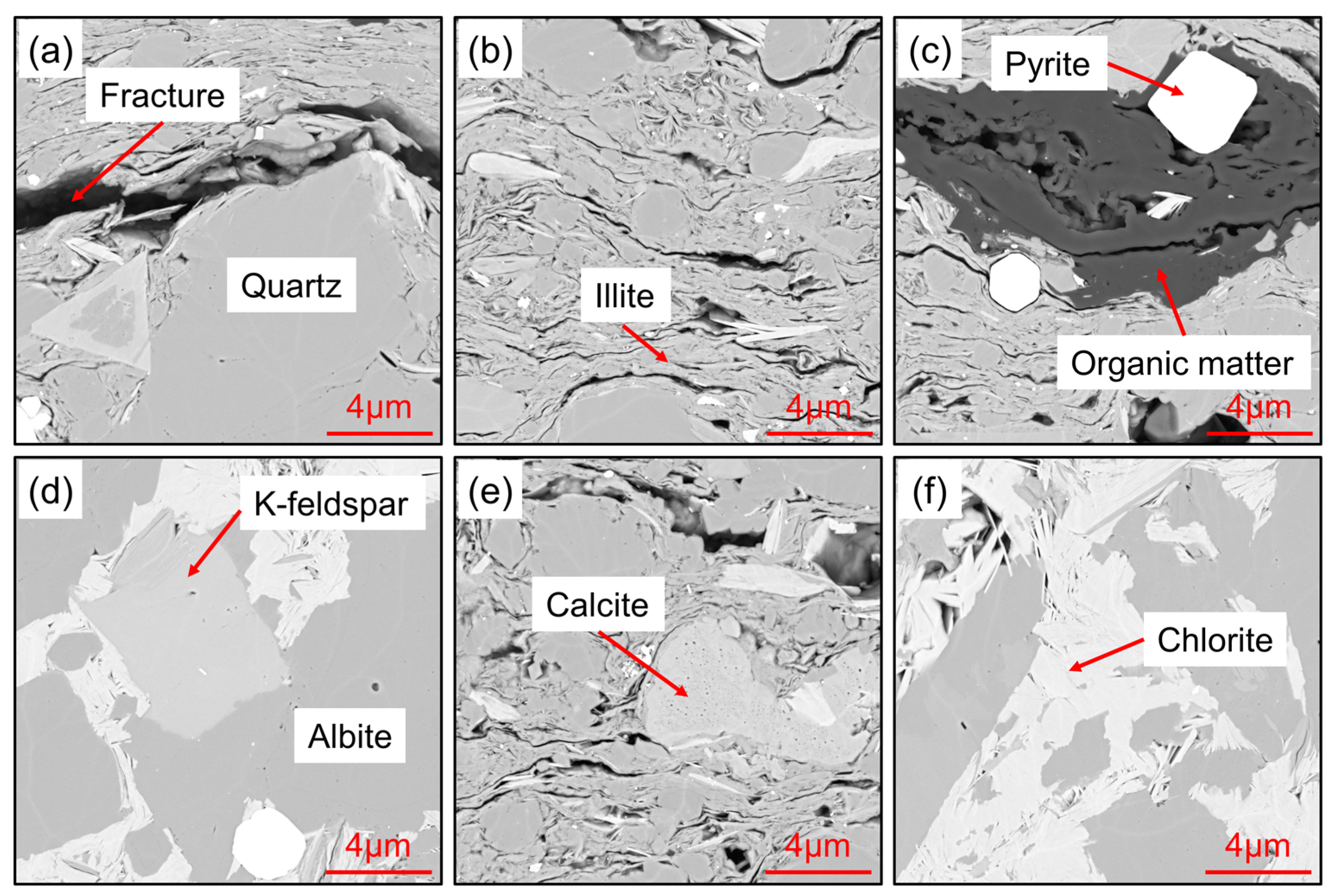


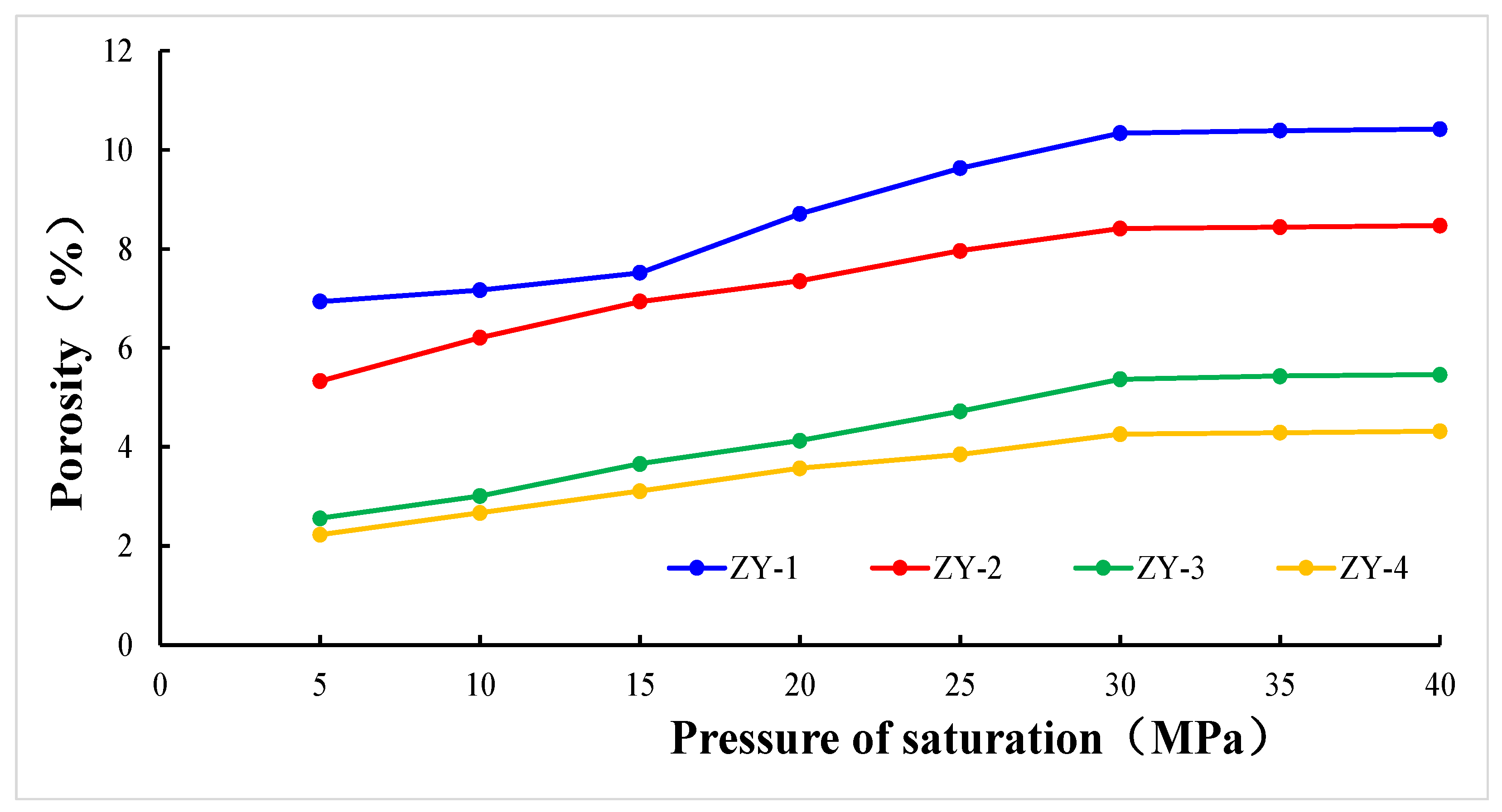
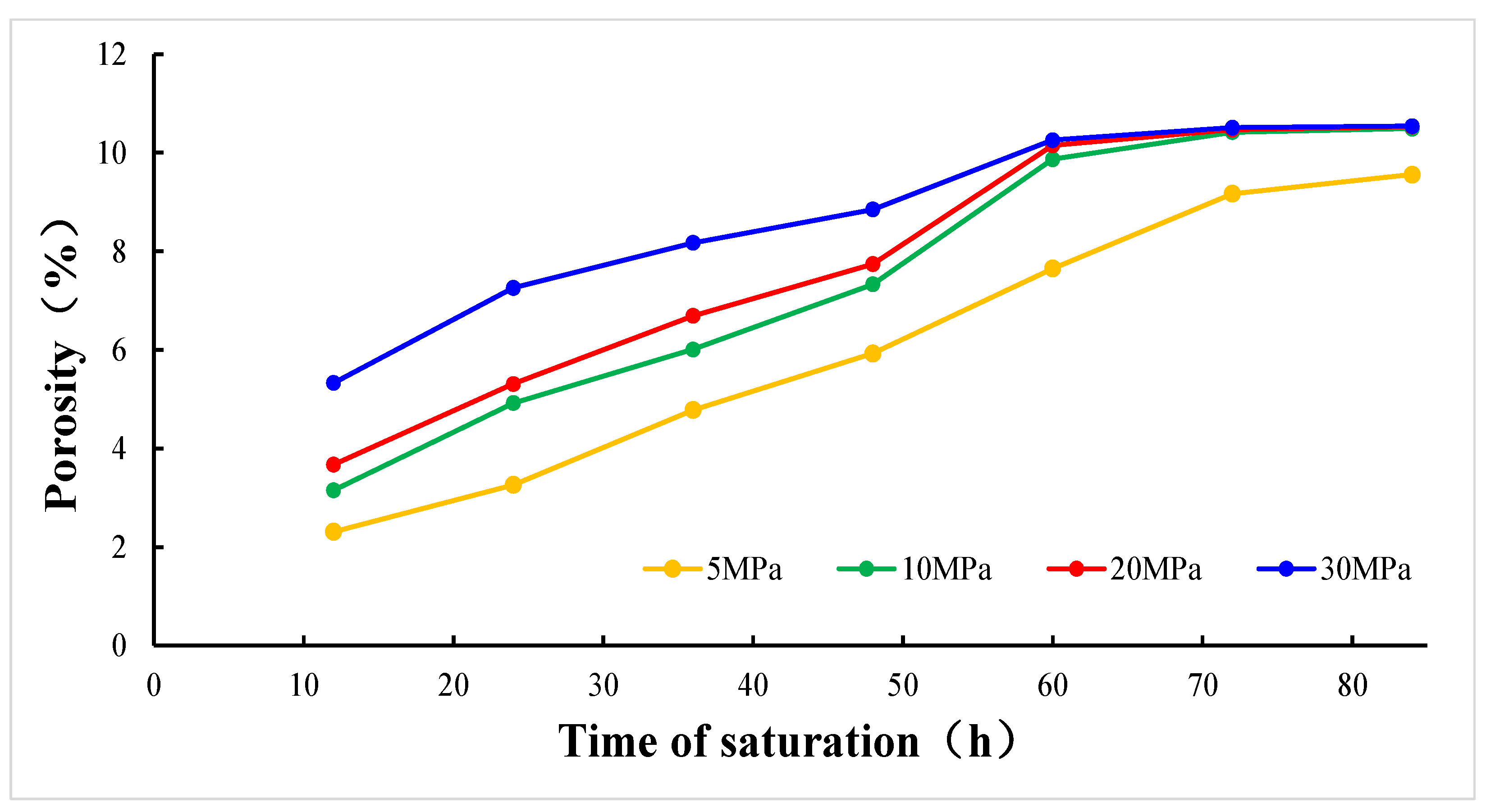

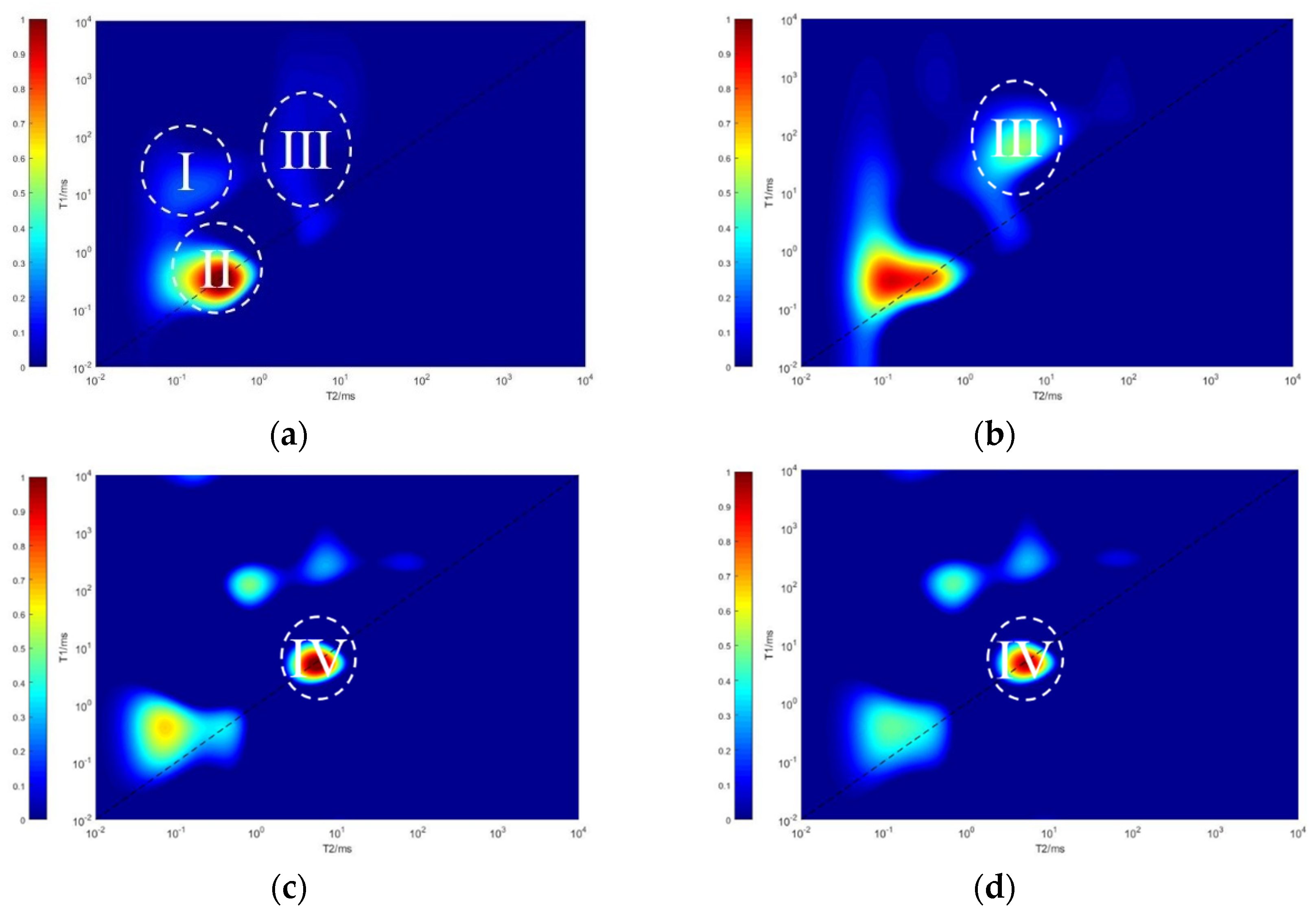


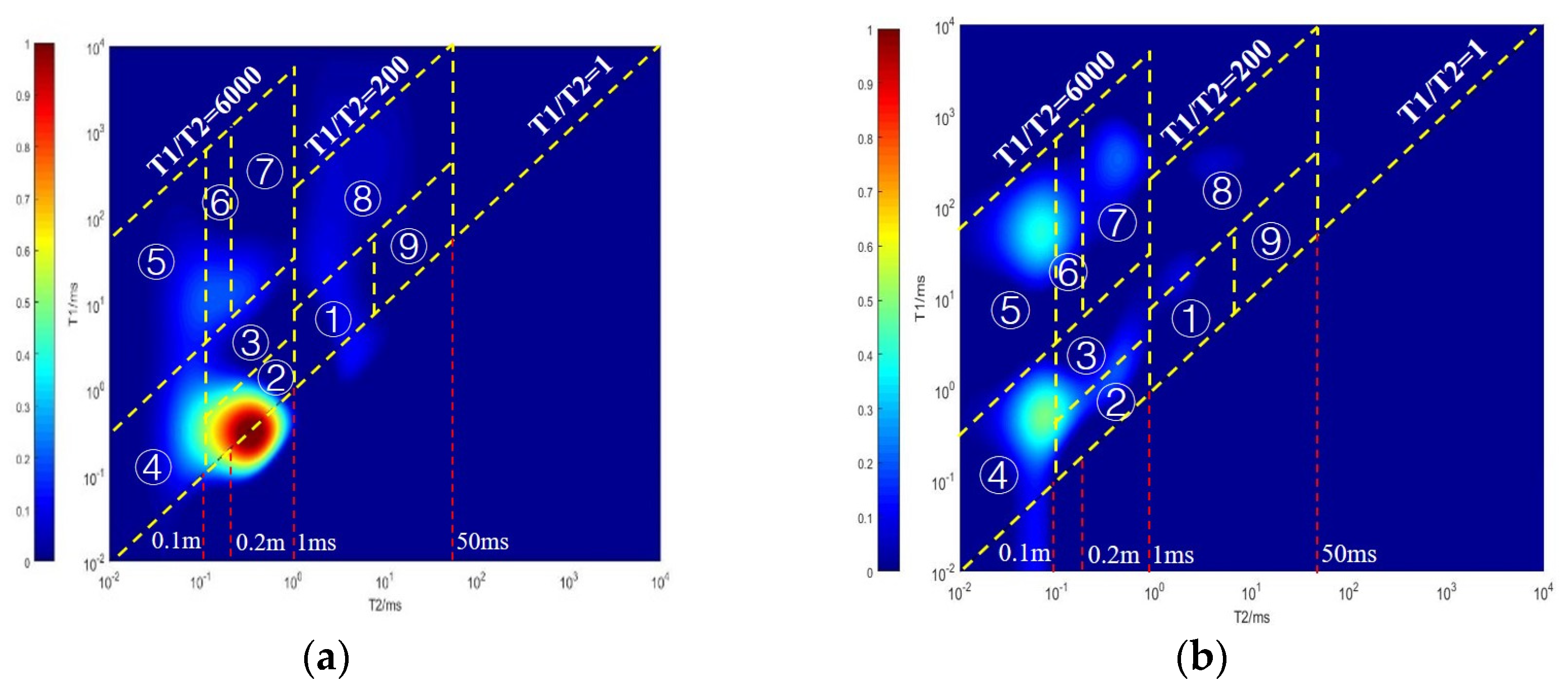
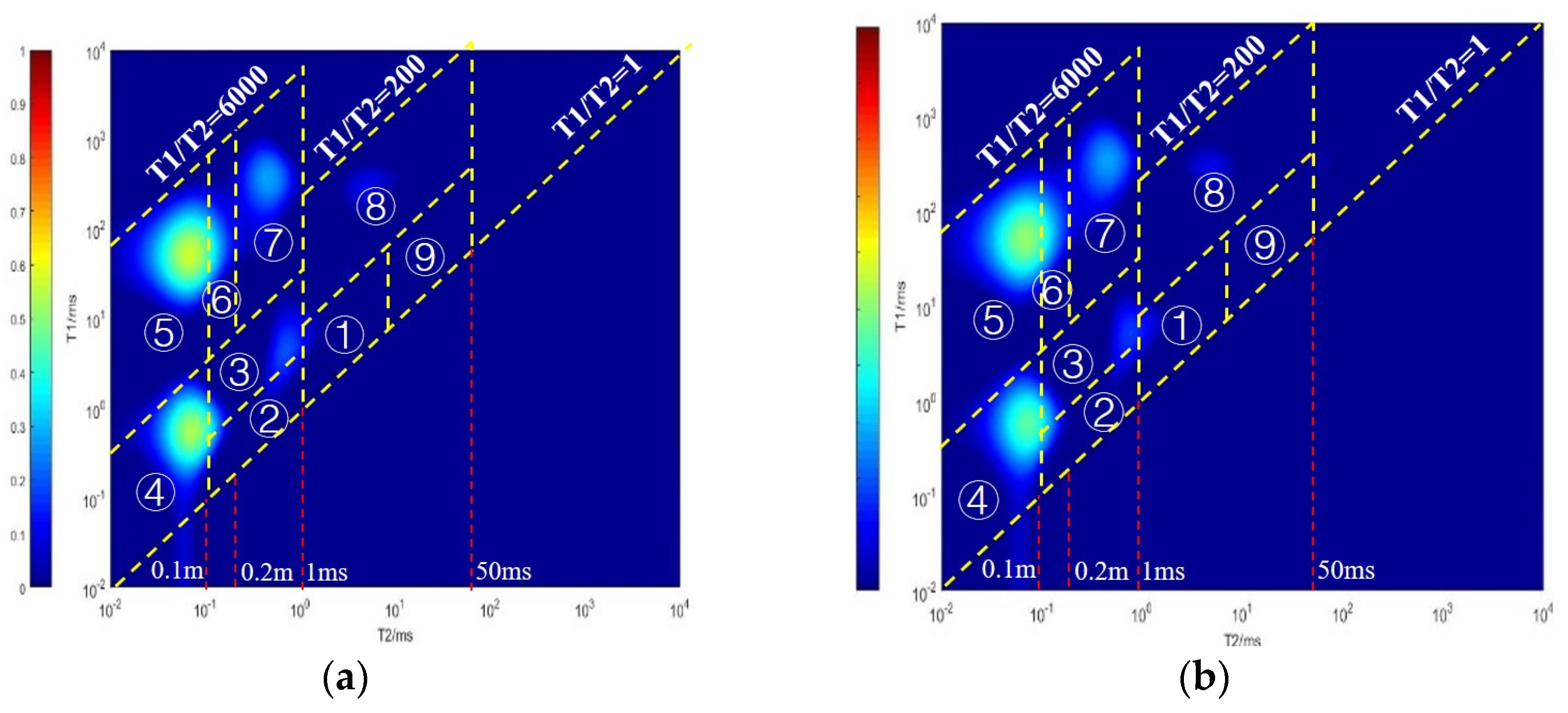
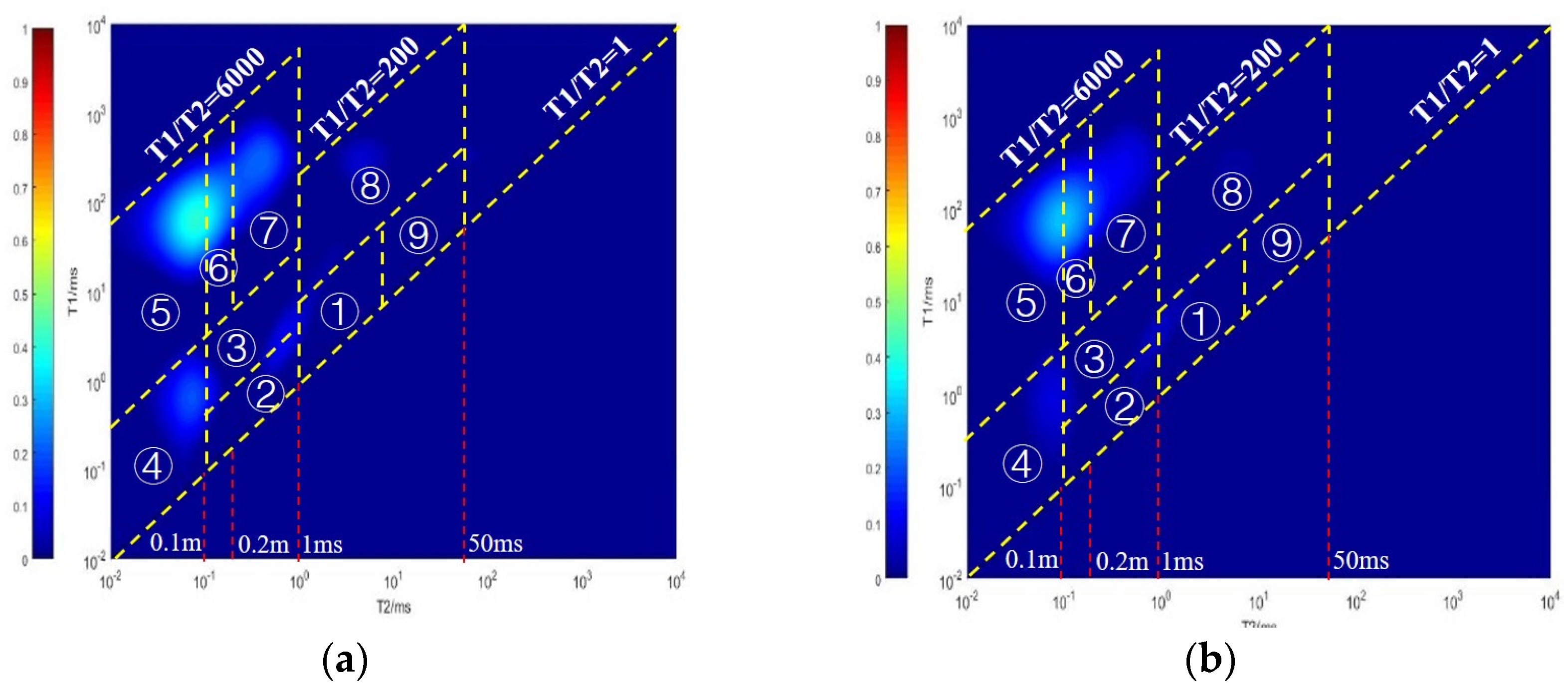

| Experiment Number | Depth | Quartz (%) | Orthoclase (%) | Plagioclase (%) | Calcite (%) | Ankerite (%) | Siderite (%) | Clay Mineral (%) |
|---|---|---|---|---|---|---|---|---|
| GY-1 | 2337.18 m | 30.2 | 1.4 | 20.4 | / | / | / | 43.5 |
| GY-2 | 2342.53 m | 41.1 | / | 26.1 | / | / | 30 | |
| GY-3 | 2347.69 m | 34.5 | / | 20.3 | / | / | 1.5 | 39.5 |
| GY-4 | 2351.46 m | 31.8 | / | 17.5 | 6.4 | 4.3 | 1.3 | 35.4 |
| GY-5 | 2356.35 m | 33.9 | / | 19.5 | 0.9 | / | / | 40.4 |
| GY-6 | 2362.44 m | 32.4 | 1.2 | 23 | 1.4 | 5.1 | 1.4 | 31.2 |
| GY-7 | 2368.92 m | 22.1 | 2.5 | 30.7 | 5 | / | 1.2 | 31.2 |
| GY-8 | 2373.51 m | 29.5 | 1.6 | 25.6 | / | / | 0.6 | 36.8 |
| GY-9 | 2379.73 m | 33.7 | 1.6 | 20.3 | / | 5.2 | / | 34.4 |
| GY-10 | 2384.08 m | 31.9 | 1 | 15.9 | 1.3 | 3.6 | / | 41.3 |
| GY-1 | GY-2 | GY-3 | GY-4 | GY-5 | GY-6 | GY-7 | GY-8 | GY-9 | GY-10 | |
|---|---|---|---|---|---|---|---|---|---|---|
| Porosity of 2D NMR (%) | 15.82 | 14.25 | 16.57 | 15.33 | 16.25 | 15.41 | 15.56 | 14.72 | 14.36 | 15.29 |
| Porosity of experiment (%) | 15.74 | 13.74 | 15.76 | 14.41 | 15.78 | 15.81 | 15.18 | 15.99 | 14.69 | 14.67 |
| Difference (%) | 0.08 | 0.51 | 0.81 | 0.92 | 0.47 | 0.4 | 0.38 | 1.27 | 0.33 | 0.62 |
| GY-1 | GY-2 | GY-3 | GY-4 | GY-5 | GY-6 | GY-7 | GY-8 | GY-9 | GY-10 | |
|---|---|---|---|---|---|---|---|---|---|---|
| Moveable oil of 2D NMR (%) | 55.3 | 49.6 | 46.2 | 55.4 | 53.3 | 46.6 | 49.1 | 47.5 | 48.3 | 53.7 |
| Moveable oil of experiment (%) | 53.2 | 48.3 | 44.5 | 56.1 | 51.2 | 45.7 | 50.4 | 45.2 | 47.6 | 54.5 |
| Difference (%) | 2.1 | 1.3 | 1.7 | 0.7 | 2.1 | 0.9 | 1.3 | 2.3 | 0.7 | 0.8 |
Disclaimer/Publisher’s Note: The statements, opinions and data contained in all publications are solely those of the individual author(s) and contributor(s) and not of MDPI and/or the editor(s). MDPI and/or the editor(s) disclaim responsibility for any injury to people or property resulting from any ideas, methods, instructions or products referred to in the content. |
© 2024 by the authors. Licensee MDPI, Basel, Switzerland. This article is an open access article distributed under the terms and conditions of the Creative Commons Attribution (CC BY) license (https://creativecommons.org/licenses/by/4.0/).
Share and Cite
Sun, F.; Sun, J.; Wang, M.; Chi, P. Analysis and Application of Fluid Components in High-Clay Matrix Shale Oil: A Case Study of Gulong Shale Oil. Energies 2024, 17, 3770. https://doi.org/10.3390/en17153770
Sun F, Sun J, Wang M, Chi P. Analysis and Application of Fluid Components in High-Clay Matrix Shale Oil: A Case Study of Gulong Shale Oil. Energies. 2024; 17(15):3770. https://doi.org/10.3390/en17153770
Chicago/Turabian StyleSun, Fujing, Jianmeng Sun, Min Wang, and Peng Chi. 2024. "Analysis and Application of Fluid Components in High-Clay Matrix Shale Oil: A Case Study of Gulong Shale Oil" Energies 17, no. 15: 3770. https://doi.org/10.3390/en17153770





